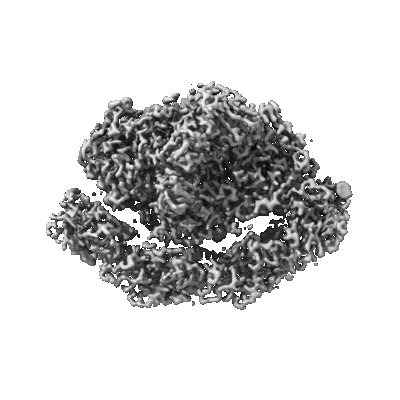EMD-4883
Structure of a minimal photosystem I from a green alga
EMD-4883
Single-particle3.2 Å
 Deposition: 23/04/2019
Deposition: 23/04/2019Map released: 19/02/2020
Last modified: 02/12/2020
Sample Organism:
Green alga
Sample: Photosystem I
Fitted models: 6rhz (Avg. Q-score: 0.467)
Deposition Authors: Perez Boerema A, Klaiman D, Caspy I, Netzer-El SY, Amunts A, Nelson N
Sample: Photosystem I
Fitted models: 6rhz (Avg. Q-score: 0.467)
Deposition Authors: Perez Boerema A, Klaiman D, Caspy I, Netzer-El SY, Amunts A, Nelson N
Structure of a minimal photosystem I from the green alga Dunaliella salina.
Perez-Boerema A  ,
Klaiman D
,
Klaiman D  ,
Caspy I
,
Caspy I  ,
Netzer-El SY,
Amunts A
,
Netzer-El SY,
Amunts A  ,
Nelson N
,
Nelson N 
(2020) Nat. Plants , 6 , 321 - 327
 ,
Klaiman D
,
Klaiman D  ,
Caspy I
,
Caspy I  ,
Netzer-El SY,
Amunts A
,
Netzer-El SY,
Amunts A  ,
Nelson N
,
Nelson N 
(2020) Nat. Plants , 6 , 321 - 327
Abstract:
Solar energy harnessed by oxygenic photosynthesis supports most of the life forms on Earth. In eukaryotes, photosynthesis occurs in chloroplasts and is achieved by membrane-embedded macromolecular complexes that contain core and peripheral antennae with multiple pigments. The structure of photosystem I (PSI) comprises the core and light-harvesting (LHCI) complexes, which together form PSI-LHCI. Here we determined the structure of PSI-LHCI from the salt-tolerant green alga Dunaliella salina using X-ray crystallography and electron cryo-microscopy. Our results reveal a previously undescribed configuration of the PSI core. It is composed of only 7 subunits, compared with 14-16 subunits in plants and the alga Chlamydomonas reinhardtii, and forms the smallest known PSI. The LHCI is poorly conserved at the sequence level and binds to pigments that form new energy pathways, and the interactions between the individual Lhca1-4 proteins are weakened. Overall, the data indicate the PSI of D. salina represents a different type of the molecular organization that provides important information for reconstructing the plasticity and evolution of PSI.
Solar energy harnessed by oxygenic photosynthesis supports most of the life forms on Earth. In eukaryotes, photosynthesis occurs in chloroplasts and is achieved by membrane-embedded macromolecular complexes that contain core and peripheral antennae with multiple pigments. The structure of photosystem I (PSI) comprises the core and light-harvesting (LHCI) complexes, which together form PSI-LHCI. Here we determined the structure of PSI-LHCI from the salt-tolerant green alga Dunaliella salina using X-ray crystallography and electron cryo-microscopy. Our results reveal a previously undescribed configuration of the PSI core. It is composed of only 7 subunits, compared with 14-16 subunits in plants and the alga Chlamydomonas reinhardtii, and forms the smallest known PSI. The LHCI is poorly conserved at the sequence level and binds to pigments that form new energy pathways, and the interactions between the individual Lhca1-4 proteins are weakened. Overall, the data indicate the PSI of D. salina represents a different type of the molecular organization that provides important information for reconstructing the plasticity and evolution of PSI.
